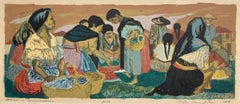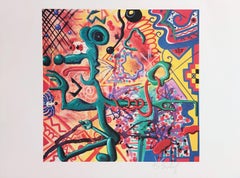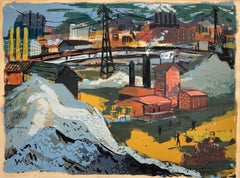Morton Dimondstein Prints and Multiples
to
1
Overall Width
to
Overall Height
to
1
4
1,183
938
886
817
1
1
1
1
1
1
1
1
1
Artist: Morton Dimondstein
MARKET IN ERONGARICUARO
By Morton Dimondstein
Located in Santa Monica, CA
MORTON DIMONDSTEIN (NY 1920 - LA 2000)
MARKET IN ERONGARICUARO 1954
Serigraph, silkscreen. Signed titled and dated in pencil. Image 10 ¼ x 25 ½ inches. Large full sheet 17 1/4 x 30...
Category
1950s American Modern Morton Dimondstein Prints and Multiples
Materials
Screen
Related Items
Headstand (San Francisco Museum of Modern Art) - Exhibition Poster
By Keith Haring
Located in Paris, IDF
Keith Haring
Headstand
Original vintage exhibition Poster printed in Screenprint
On thick paper
90 x 60 cm (c. 36 x 24 in)
INFORMATION: Official screenprint poster for the Haring e...
Category
1980s American Modern Morton Dimondstein Prints and Multiples
Materials
Screen
Ratfinkbonerthunk : Surrealist Rat - Original Giclee Print, Handsigned
By Kenny Scharf
Located in Paris, IDF
Kenny Scharf
Ratfinkbonerthunk : Surrealist Rat, 1990
Original Giclee Print
Handsigned in pencil
On Arches vellum 56 x 76 cm (c. 22 x 30 in)
Published by Editions Vermorel in 1990
...
Category
1990s American Modern Morton Dimondstein Prints and Multiples
Materials
Giclée, Screen
$1,778
H 22.05 in W 29.93 in
Harry Shokler, Island Harbor
By Harry Shokler
Located in New York, NY
Harry Shokler used serigraphy to great advantage in this landscape. It's colorful and detailed.
It is signed in the image at the lower left. When printmakers began making serigraphs...
Category
1940s American Modern Morton Dimondstein Prints and Multiples
Materials
Screen
Original Mardi Gras New Orleans 1978 festival serigraph poster
Located in Spokane, WA
Original Mardi Gras, New Orleans, 1978 linen-backed poster. Dressed up in what would be an American Indian costume with full headgear, he is holding a shield with a horse on it. Indian decoration on the footwear. Signed and numbered.
I believe this has to deal with Big Chief leading his Congo Nation Mardi Gras Indian group. Zulu Parade. Many of the original Mardi Gras jazz posters...
Category
1970s American Modern Morton Dimondstein Prints and Multiples
Materials
Screen
$636 Sale Price
20% Off
H 32 in W 23 in D 0.05 in
Modernist Figurative Pop Art Etching and Aquatint "the Artist" Michael Mazur
By Michael Mazur
Located in Surfside, FL
Michael Mazur
"The Artist"
Hand signed and editioned from the edition of 50
1967
Michael Burton Mazur (1935-August 18, 2009) was an American artist who was described by William Grim...
Category
Early 2000s American Modern Morton Dimondstein Prints and Multiples
Materials
Lithograph, Screen
Original Continental Airlines limited edition Serigraph vintage travel poster
Located in Spokane, WA
Original Continental Airlines travel poster. Linen backed in fine condition. Signed and numbered 35/50.
This original Continental Airlines poster is an artistic representation of regional destinations prominently served by Continental Airlines in the past. The design is modern and bold, showcasing a unique black-and-white theme with strong, futuristic typography and graphical illustrations. Each city is creatively depicted using stylized imagery that resonates with its character—Oklahoma City features a cowboy motif, New Orleans embraces a jazzy, cultural essence, Dallas reflects the energy of movement, and Midland/Odessa highlights industrial and oil-centric themes.
This limited-edition poster is printed in black and white. It features the destinations of Hawaii, San Francisco, Albuquerque and Portland Above each name is a design that represents each destination city.
Hawaii has rows of palm trees and hula dancers. San Francisco has rolling hills and cable cars. Albuquerque has tribal Indians dancing. Portland has the cruise shipping. This image features the Saul Bass l967 Continental logo in the design.
Continental Airlines was a major United States airline founded in 1934 and eventually headquartered in Houston, Texas.
The airline was acquired by UAL Corporation, the parent company of United Airlines, on October 1, 2010.
This is an original vintage Continental Airlines poster...
Category
Late 20th Century American Modern Morton Dimondstein Prints and Multiples
Materials
Screen
$675
H 40 in W 26.5 in D 0.3 in
"New Hampshire Lobster with Chips" - Screen Print by Timothy Lee
Located in Soquel, CA
"New Hampshire Lobster with Chips" - Screen Print by Timothy Lee
The artwork "N.H. Lobster" by Timothy Lee, created in 1983, is a print that combines elements of realism and abstrac...
Category
1980s American Modern Morton Dimondstein Prints and Multiples
Materials
Laid Paper, Screen
$1,050
H 14 in W 11 in D 0.5 in
"Balcony" 1938 WPA Print Mid 20th Century American Broadway Theatre Modernism
By Leon Bibel
Located in New York, NY
"Balcony" 1938 WPA Print Mid 20th Century American Broadway Theatre Modernism.
Silk screen on paper, 15” x 20". Numbered 15/20 lower left. Pencil si...
Category
1930s American Modern Morton Dimondstein Prints and Multiples
Materials
Paper, Screen
Stewart Wheeler, Atlantic City (New Jersey)
Located in New York, NY
The little that is know about the painter and printmaker Stewart Wheeler indicates that most of his career was spent in Philadelphia, Pennsylvania. And...
Category
Mid-20th Century American Modern Morton Dimondstein Prints and Multiples
Materials
Screen
Black Break, Screenprint by LeRoy Neiman
By LeRoy Neiman
Located in Long Island City, NY
Artist: LeRoy Neiman, American (1921 - 2012)
Title: Black Break
Year: 1973
Medium: Screenprint, signed and numbered in pencil
Edition: AP, 300
Size: 26 in. x 20.2 in. (66.04 cm x 51...
Category
1970s American Modern Morton Dimondstein Prints and Multiples
Materials
Screen
Flowers - Original Screen Print - Handsigned and /100 (Schellman II.101)
By Andy Warhol
Located in Paris, IDF
Andy Warhol (1928-1987)
Flowers (black and white), 1986
Original silkscreen (Printer Alexander Heinrichi, New York)
Signed in pencil with the monogram lower right
Countersigned in p...
Category
1980s American Modern Morton Dimondstein Prints and Multiples
Materials
Screen
$10,671
H 40.56 in W 27.17 in
Vintage Poster Saul Steinberg Galerie Maeght Paris France
By Saul Steinberg
Located in Surfside, FL
SAUL STEINBERG (American 1914-1999) Via Air Mail Geometric Design Lithograph. Sheet: 21 1/2 x 28 inches; Frame: 22 1/4 x 29 inches. Plate signed and dated l/r with sticker upper ri...
Category
1970s American Modern Morton Dimondstein Prints and Multiples
Materials
Screen
Previously Available Items
Industrial # 2
By Morton Dimondstein
Located in Santa Monica, CA
MORTON DIAMONDSON ((1920 - 2000)
INDUSTRIAL # 2, 1947
Serigraph. image, 11 1/4 x 15 1/2 inches Sheet 15 x 21 inches. Signed and titled on pencil. Mat burn surrounding the image in...
Category
1940s Modern Morton Dimondstein Prints and Multiples
Materials
Screen
Morton Dimondstein prints and multiples for sale on 1stDibs.
Find a wide variety of authentic Morton Dimondstein prints and multiples available for sale on 1stDibs. You can also browse by medium to find art by Morton Dimondstein in screen print and more. Much of the original work by this artist or collective was created during the 1950s and is mostly associated with the modern style. Not every interior allows for large Morton Dimondstein prints and multiples, so small editions measuring 26 inches across are available. Customers who are interested in this artist might also find the work of Harry Sternberg, Bernard Brussel-Smith, and Arthur William Heintzelman.. Morton Dimondstein prints and multiples prices can differ depending upon medium, time period and other attributes. On 1stDibs, the price for these items starts at $475 and tops out at $475, while the average work can sell for $475.


